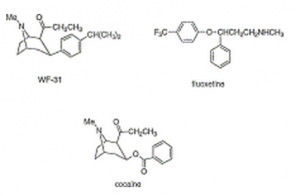Authors: James B. Daunais, Stephanie L. Hart, Ashlee Hedgecock-Rowe, Julius J. Matasi, Craig Thornley, Huw M.L. Davies, Linda J. Porrino
Molecular Brain Research
1997, 50, 1-2, 293-304
The effects of the acute administration of the serotonin-selective tropane analog, [2β-propanoyl-3β-(4-isopropylphenyl)-tropane, WF-31, on spontaneous locomotor activity were measured and compared to those of the highly selective serotonin uptake inhibitor, fluoxetine and cocaine, a non-selective re-uptake inhibitor of dopamine and serotonin. WF-31 (1, 10 and 30 mg/kg)-elicited increases in locomotor behaviors when compared to vehicle-treated rats. This increased activity was blocked by pre-treatment with the dopaminergic antagonist, flupenthixol, suggesting that these effects may be mediated by dopaminergic mechanisms. Cocaine, but not fluoxetine, also elicited increases in behaviors. In addition, the effects of these three compounds on opioid peptide gene expression were also assessed using in situ hybridization histochemistry in the same animals. The acute administration of both WF-31 and cocaine increased the expression of preprodynorphin mRNA in the dorsal striatum whereas fluoxetine had no effect. Expression of striatal preproenkephalin mRNA was augmented by all three compounds. Within the nucleus accumbens, PPD mRNA levels were affected only by treatment with WF-31, an effect that was blocked by pre-treatment with flupenthixol. In contrast, the acute administration of both WF-31 and fluoxetine, but not cocaine, increased the expression of preproenkephalin mRNA. These increases, however, were not reversed by pre-treatment with flupenthixol. Despite its profile in vitro as a relatively selective serotonin re-uptake inhibitor, some of the in vivo actions of WF-31 appear to be mediated by dopaminergic mechanisms. These data further suggest that the mechanisms underlying expression of the opioid peptides in the nucleus accumbens may vary from those in the dorsal striatum.


